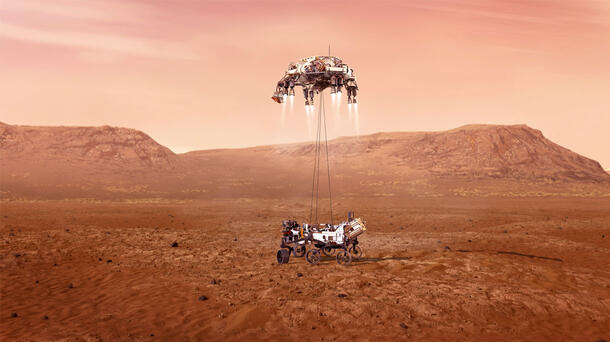Exploration Firsts
Seeking signs of ancient life, the mission will collect and store soil and rock samples that could eventually be safely transported, stored and studied here on Earth. NASA will also attempt to produce oxygen from the Martian atmosphere – another pioneering step in the quest for human exploration.
The mission will test future-looking technologies, including autonomous guidance which is essential for landing humans safely. The deployment of the Ingenuity helicopter, a new aerial dimension which will enable future robotic and human missions to Mars.
The Perseverance rover is equipped with more cameras than any other interplanetary mission in history, and a microphone will enable the full experience - capturing natural sounds on Mars. This immersive experience will be broadcast on the mission’s website.
60 Years of Complementary Innovation
L3Harris’ work in space goes back a lifetime. Complementary innovation by L3Harris has enabled lunar rover exploration and images from space crews, while the Apollo missions have relied on our antenna systems to help recover teams and locate command modules after splashdown.
“For more than 60 years, L3Harris has provided highly reliable avionics and communications technology resulting in failure-free NASA missions,” said Clayton McClain, General Manager, Space & Sensors, L3Harris.
That record of flawless execution extends to the current Mars mission.
“L3Harris avionics, sensors and transceivers are key components in the Mars 2020 mission, enabling unprecedented image and data capture as well as transmission to overhead orbiters,” said Murali Krishnan, President, Electro Optical sector, L3Harris. “They provide the communication link between the surface of Mars and all of the science instruments, allowing the science data and images to be sent to the overhead obiters.”
For twenty years, every United States Martian rover and orbiting spacecraft has used L3Harris transceivers on their missions. Flexible by design, the unit accommodates many mission scenarios where data links are required between two spacecraft.
“Quality is critical,” explains Mark Dapore, Technical Director and Fellow, Space & Sensors, L3Harris. “There is no ability to repair or replace the units once the rover has launched. A rover and its science instruments which cannot be commanded or its data returned is a failure of the mission.”
The Story Begins
Perseverance is the most sophisticated rover yet, launched on a United Launch Alliance Atlas V rocket July 30, 2020 at 7:50 a.m. EDT, with telemetry reporting to NASA ground stations at 11:30 a.m. EDT that the spacecraft had entered “safe mode.” Now, after 290 million miles travelled to Jezero Crater, the story is just beginning.
The mission, scheduled to last one Martian year, or 687 Earth days, requires hardened, durable and proven solutions such as those that L3Harris is trusted to provide. Historically, rovers have performed far beyond their expected life. The Spirit rover, for example, was originally planned as a 90 day mission and exceeded expectation with last contact at almost seven years. Opportunity communicated with ground stations for nearly 15 years after a planned mission of 90 days and it is possible that Perseverance will communicate for at least a decade.
The Future is Bright
“It takes an innovative culture, strict attention to detail and highly talented people to get equipment qualified to go to Mars,” said Krishnan. “Our communication transceivers’ performance and bandwidth has continually increased while maintaining the stringent mass and energy constraints of the Perseverance program.”
Each action taken by the rover is coordinated by NASA’s Jet Propulsion Laboratory (JPL). A list of instructions is prepared by the JPL control engineers, and tested on earth, then transmitted to the rover. The instruction list, received via the L3Harris radio, provides the step-by-step work performed by the rover each day.
L3Harris has been supporting NASA’s programs for more than six decades, beginning with technologies for early spacecraft and continuing through the Mercury, Gemini, Apollo, Space Shuttle, International Space Station and previous Mars missions.
The future is bright for the Mars 2020/Perseverance mission – there is a high potential for finding past microbial life – providing a deepened understanding of whether life existed on Mars. Gathering samples of Martian rock and regolith has been a goal of planetary scientists since the early days of the space age, and for decades, L3Harris has been providing innovations to keep our customers and their missions connected, successful and safe.





